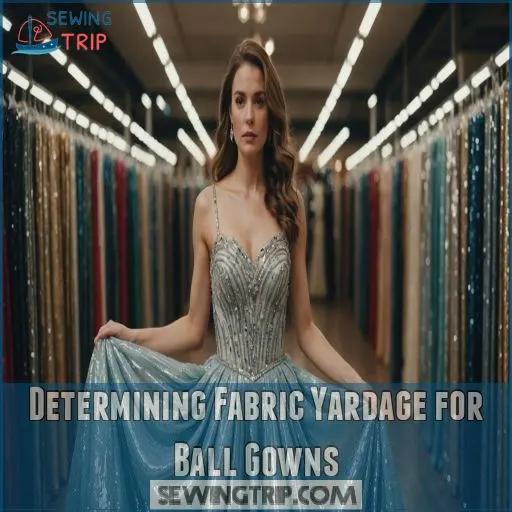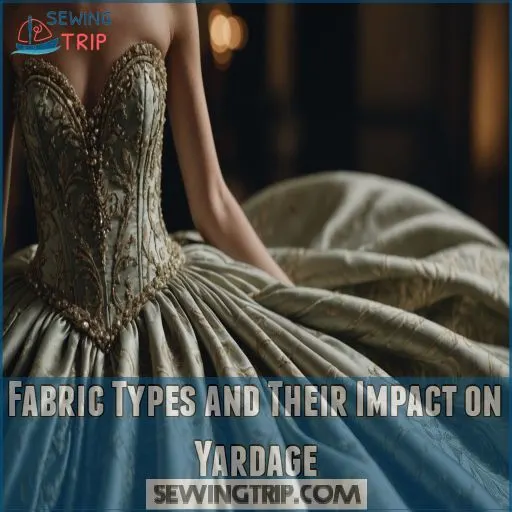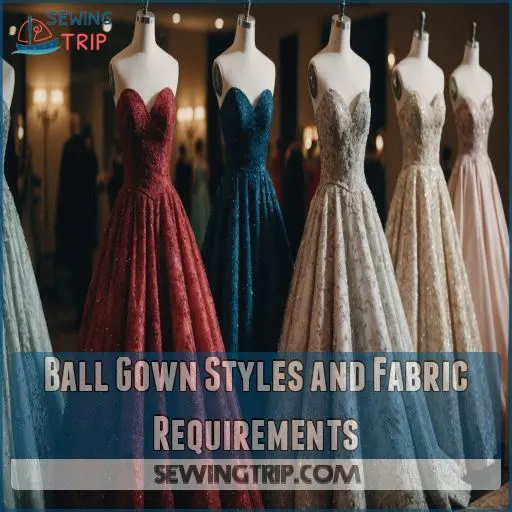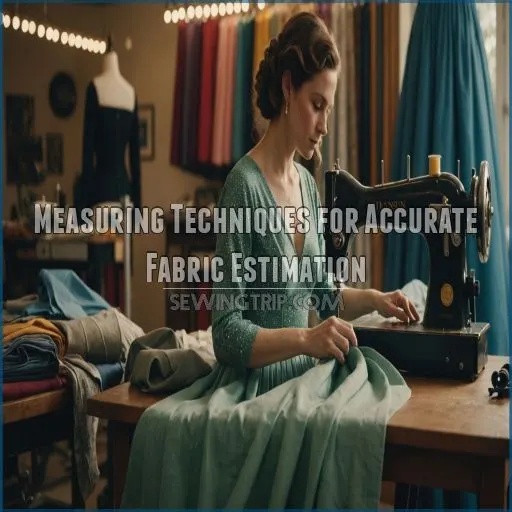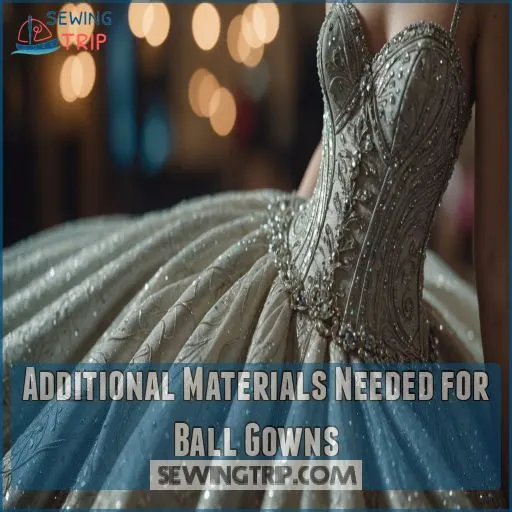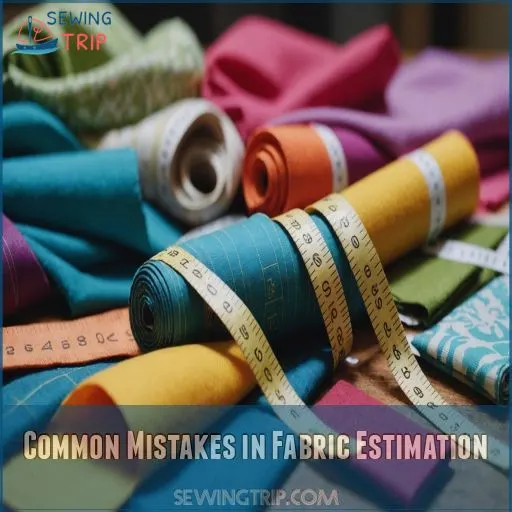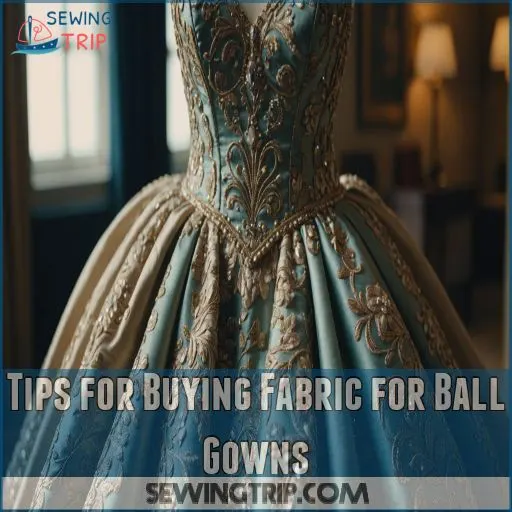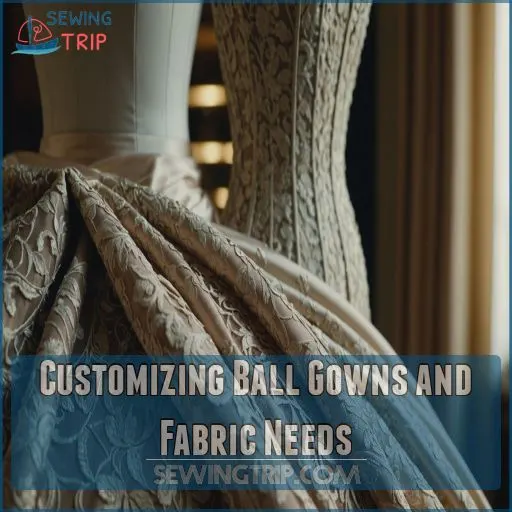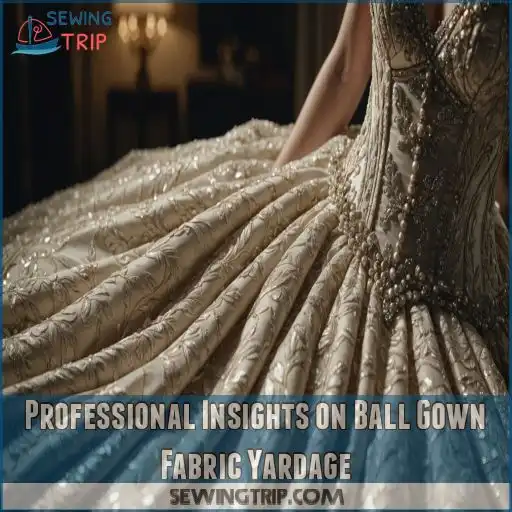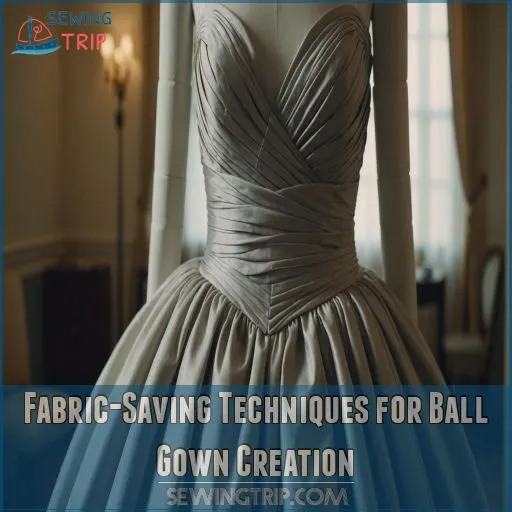This site is supported by our readers. We may earn a commission, at no cost to you, if you purchase through links.
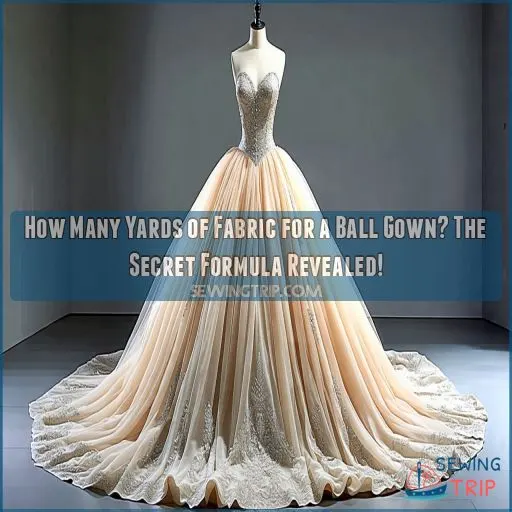 So, you’re planning to craft a stunning ball gown and wondering how many yards of fabric you’ll need? Typically, you’re looking at 8 to 12 yards, depending on the gown’s flair and fabric type.
So, you’re planning to craft a stunning ball gown and wondering how many yards of fabric you’ll need? Typically, you’re looking at 8 to 12 yards, depending on the gown’s flair and fabric type.
If you’re dreaming of something voluminous with lots of swirls and twirls, leaning towards the higher end is wiser. But remember, it’s not just about the yards; the fabric width and your design’s intricacies play a big part.
Maybe you love tulle for that fairy tale vibe or something with a bit more drape. And here’s a sewing secret: always grab a bit extra—better safe than sorry!
Table Of Contents
- Key Takeaways
- Determining Fabric Yardage for Ball Gowns
- Fabric Types and Their Impact on Yardage
- Ball Gown Styles and Fabric Requirements
- Measuring Techniques for Accurate Fabric Estimation
- Additional Materials Needed for Ball Gowns
- Common Mistakes in Fabric Estimation
- Tips for Buying Fabric for Ball Gowns
- Customizing Ball Gowns and Fabric Needs
- Professional Insights on Ball Gown Fabric Yardage
- Fabric-Saving Techniques for Ball Gown Creation
- Frequently Asked Questions (FAQs)
- Conclusion
Key Takeaways
- When planning your ball gown, think about needing 8 to 12 yards of fabric. Go bold with extra if your design calls for lots of flair, like swirls and twirls, because it’s better to be safe than to run short.
- Choose your fabric type wisely. Dreamy tulle screams fairy tale but requires more yardage. Smooth satin might save on yards with its drape. So, consider how your fabric choice affects your plan.
- Before cutting, measure twice—just like carpenters do. Seam allowances and pattern matching can sneak up on you like a twist in a movie plot. Having a bit more fabric is like having popcorn handy—it’s always worth it.
- Remember that those extra details like ruffles or a sweeping train might gobble up more fabric than expected. Keep your creativity unrestricted by factoring in these finishing touches to avoid a mid-sewing panic.
Determining Fabric Yardage for Ball Gowns
Ever stared at bolts of fabric, wondering if you’ll end up with a stunning ball gown or a curtain catastrophe?
Don’t sweat it – we’ve got the inside scoop on cracking the fabric yardage code for your dreamy dress, so you can waltz into your next big night feeling like Cinderella.
(minus the pumpkin mishap), with your next big night all sorted.
Standard Yardage Requirements
Imagine this: you’re about to start your ball gown journey, but you’re scratching your head over fabric yardage.
Don’t sweat it! For a classic ball gown, you’ll typically need 8 to 12 yards of fabric.
Your pattern type and fabric width are key players here. Remember, it’s better to err on the side of caution and grab a bit extra.
You’ll thank yourself later when you’re free to create without constraints!
Factors Affecting Fabric Amount
Now that you’ve got a ballpark figure, let’s unpack the fabric puzzle. Your gown’s appetite for fabric depends on a buffet of factors.
Skirt volume is the main course – a princess-style ball gown gobbles up more fabric than its sleek cousins. The bodice design and embellishments are like side dishes, adding to your fabric consumption.
For instance, heavier fabrics and those with more drape require more yardage, while considering fabric drape and weight can help you make a more accurate estimate.
Additionally, seams, hems, and design details like ruffles or pleats consume extra fabric yardage, making them essential considerations in your calculations.
Don’t forget about fabric width – it’s the secret ingredient that can make or break your yardage calculations!
Calculating Fabric Needs Based on Pattern
The secret’s in the pattern, ladies!
Grab your yardage calculator and let’s unravel this fabric mystery together.
Your pattern’s sizing is your golden ticket to fabric quarter yardage freedom
.
First, measure twice, cut once – that’s the mantra.
Don’t forget to factor in seam allowances and pattern matching. It’s like a puzzle, but you’re the master!
A handy fabric guide can be your best friend here, and a key to fabric freedom.
Adjusting for Custom Designs
Custom designs dance to their own tune, so you’ll need to tweak your fabric calculations.
Adding sleeves or layered skirts? Tack on extra yardage. Dreaming of a dramatic train? Factor in that flowing extension.
Multiple fabrics for a show-stopping bodice? Adjust accordingly. Remember, fabric embellishments and draping can eat up material like nobody’s business.
Don’t let your creativity be hemmed in—embrace the freedom to design, but keep your measuring tape handy to avoid running out of fabric, so your creativity isn’t limited by nobody’s business.
Fabric Types and Their Impact on Yardage
You’ve got your measurements, but hold your horses! Fabric choice can make or break your ball gown dreams. Let’s talk shop about how different fabrics can turn your yardage estimates topsy-turvy.
Picture this: you’re swooning over a dreamy satin. Its smooth drape means you might need less fabric than you think. But wait! That gorgeous tulle you’ve been eyeing? It’s a whole different ball game. You’ll need yards and yards to achieve that floaty, fairy-tale look.
Fabric weight plays a big role too. Heavier fabrics like brocade will hang differently than lightweight chiffon, affecting how much you’ll need. And don’t forget about texture impact! A heavily embellished fabric might require extra yardage to match patterns.
Always buy a smidge more than you think you need. It’s better to have leftovers for a matching clutch than to come up short!
Ball Gown Styles and Fabric Requirements
You’ll need different amounts of fabric depending on your ball gown style.
From sleek mermaid cuts to flowing A-lines.
Whether you’re channeling Cinderella or going for a modern twist, we’ll break down the yardage you’ll need to make your dream gown a reality.
A-line Gowns
Now, let’s talk about A-line gowns – the darling of ball gown trends.
These beauties flare gently from the shoulders, creating that coveted "A shape."
You’ll need about 5-7 yards of fabric, depending on your height and the gown’s fullness (Source). Lightweight fabrics like silk charmeuse or cotton blends work wonders
.
Remember, A-line gowns are like a hug for your curves – they flatter every body type!
Princess-cut Gowns
Ready to feel like a true royal?
Princess-cut gowns are the crown jewels of ball gowns. These beauties feature a fitted bodice that hugs your curves and a dramatic, full skirt that’ll have you twirling all night.
You’ll need extra fabric for that dreamy silhouette, so plan on 8-10 yards of your chosen material.
Remember, with great yardage comes great responsibility – and a chance to shine like the diamond you’re !
Mermaid-style Gowns
The siren call of a mermaid-style gown is hard to resist! You’ll need about 6-8 yards of fabric to create that show-stopping silhouette .
For a seamless fit, choose stretchy fabrics that hug your curves like a glove.
Tailoring tips: focus on a fitted bodice and dramatic flare below the knees.
Don’t forget proper undergarments to smooth your silhouette.
Fabric stores often have experts who can guide you through fabric choices for that perfect, head-turning mermaid gown.
Empire Waist Gowns
Empire waist gowns are a welcome change in the fashion scene.
You’ll need less fabric than mermaid styles, but don’t skimp on the skirt fullness! For a dreamy look, aim for 5-6 yards of 52" wide fabric.
The high waistline creates a flattering silhouette, perfect for channeling your inner Jane Austen heroine.
Remember, the bodice details and fabric drape are key to nailing that Regency-inspired elegance.
Ball Gown With Train
With a swish of fabric, you’re stepping into ball gowns with trains. You’ll need extra yardage to create that show-stopping trail behind you.
Let’s get into the details:
- Train length: From subtle sweep to cathedral drama
- Train style: Detachable for dance floor freedom or built-in for constant elegance
- Train fabric: Match your gown or go bold with contrasting tulle
Remember, you’re not just buying fabric; you’re investing in your fairytale moment. Let’s make it count!
Measuring Techniques for Accurate Fabric Estimation
Before you start your ball gown project, let’s talk measuring techniques. You’ll want to become a fabric estimation ninja to avoid any last-minute fabric store panic attacks!
First things first, grab your trusty measuring tape and a friend. You’ll need accurate body measurements to nail that perfect fit.
| Measurement | How-To |
|---|---|
| Bust | Measure around fullest part |
| Waist | Find natural waistline |
| Hips | Measure widest part |
| Length | Shoulder to floor |
| Arm | Shoulder to wrist |
Don’t forget to factor in seam allowances and hem length. For a voluminous ball gown, you might need 8 to 12 yards of fabric. Remember, it’s better to have a little extra than to come up short. And hey, if you end up with leftover fabric, you can always whip up a matching clutch or hair accessory!
Additional Materials Needed for Ball Gowns
You’ve got your gorgeous fabric, but hold up—
There’s more to a ball gown than meets the eye.
Let’s unpack the secret stash of extras you’ll need to transform that fabric into a show-stopping gown that’ll have you feeling like royalty (minus the crown, unless that’s your thing).
Lining Fabric
Choosing the right lining fabric is like picking the perfect dance partner for your ball gown. It should glide smoothly and feel just right.
- Lining fabric types affect weight and structure – opt for lightweight and breathable options like silk lining fabrics, such as Habutai or Charmeuse, for a luxurious feel. For instance, silk Charmeuse and silk Crepe De Chine are excellent lightweight lining options that maintain the drape of dupioni silk.
- Lining color matching creates a seamless look.
- Lining construction influences how your gown flows.
Now you’re ready to add magic!
Interfacing and Boning
Imagine your ball gown transforming into a masterpiece with the right interfacing and boning. These elements provide structure and support where needed. Use different interfacing types and boning materials for strategic boning placement.
| Interfacing Types | Boning Placement | Boning Materials |
|---|---|---|
| Fusible | Side Seams | Steel |
| Sew-in | Bodice Center | Spiral Steel |
| Woven | Skirt Hem | Plastic |
Interfacing uses and boning support are key to success!
Embellishments and Trims
Don’t let your ball gown fade into obscurity—add pizzazz with embellishments. Consider intricate beading or delicate lace for elegance.
Want sparkle? Sequins will do the trick.
Fabric flowers and ribbon work add romance, while a lace-trimmed hem or sturdy nylon tulle offers structure.
Keep an eye on fabric density and thickness for easier fabric manipulation, especially when working with intricate beading.
Closures and Fastenings
A few well-placed buttons or a discreet zipper can make all the difference in your ball gown.
Opt for classic hook-and-eye closures at the neckline or corset lacing in the back for a touch of vintage glamour.
Whichever closure you choose, make sure it complements the fabric and style of your dress for a polished, professional look.
Common Mistakes in Fabric Estimation
Even when you’ve got your lining and trims ready, fabric estimation for ball gowns can land you in hot water. Common mistakes often trip you up—like ignoring fabric shrinkage or underestimating seam allowance.
Imagine this: you’ve just finished a stunning ball gown only to find it two sizes too small because you forgot to account for these sneaky factors. And let’s not forget about pattern matching, which can mess with your fabric yards if overlooked.
Another blunder? Not thinking about embellishments or the fabric width, which could mean more trips to the store. It’s fabric advice you shouldn’t ignore—embracing current fabric trends and innovations makes sure you’re not left with a ball gown that’s more of a ball bummer.
Tips for Buying Fabric for Ball Gowns
When you’re hunting for fabric for your ball gown, think about the width and remember that patterns might need matching, so grab a little extra to cover mistakes.
Just like packing an umbrella on a cloudy day, buying more fabric than you think you need can save you from a downpour of last-minute scrambling.
This approach is similar to preparing for unpredictable weather, and it can greatly benefit your sewing project, helping you avoid a last-minute crisis.
Fabric Width Considerations
Consider fabric width before buying for your ball gown, especially when working with apparel fabric widths
. Wide fabrics mean less yardage but can impact design. For example, narrower fabrics like those with a width of 35-36 inches may require more yardage, up to 2-1/4 to 3-1/4 yards, whereas wider fabrics can get away with 1-1/4 to 2-1/4 yards Fabric Yardage Requirements.
- Width vs Yardage: Opt for wider fabric to minimize yards needed.
- Fabric Weave: Choose a texture that complements your design.
- Width and Pattern: Make sure your pattern aligns with the width easily.
Enjoy the freedom of informed choices!
Accounting for Pattern Matching
Imagine crafting a ball gown with a stunning fabric print. You’ll need to master pattern matching for a flawless matching print panels to avoid those pesky mismatched seams
. Aligning repeating patterns demand extra fabric yards.
Here’s a tip: check your fabric width and plan carefully to reduce fabric waste.
| Factor | Impact on Fabric | Example |
|---|---|---|
| Fabric Width | Affects yardage | 45" vs 58" |
| Repeating Patterns | Align seams | Stripes |
| Pattern Placement | Minimizes waste | Florals |
Achieve that seamless elegance!
Buying Extra for Mistakes
While pattern matching helps make sure your ball gown turns up as desired, buying extra fabric is essential.
It covers mistakes that sneak up on you. Mistakes happen, and fabric waste can bust your budget if you’re not careful.
You can purchase extra yardage from fabric merchants or distributors.
This way, you’ll blend sewing errors into masterful creations seamlessly.
Customizing Ball Gowns and Fabric Needs
When you’re customizing a ball gown, the fabric yardage can change faster than your favorite dress size during a sale.
Whether you’re adding sleeves, layering skirts, or juggling multiple fabrics, the secret to getting it right is all in the numbers, and understanding this concept is the key to a successful customization process, which can be summed up in two words: the numbers.
Adding Sleeves or Straps
Dreaming of adding sleeves or straps to your ball gown? No problem.
To make sure a smooth fit, consider using soft cottons or knits that iron smoothly, and don’t forget to prewash and iron fabric before cutting.
- Opt for classic long sleeves using 1.5 to 3 yards of fabric.
- Go for a chic cap sleeve with just 1 to 1.25 yards per sleeve.
- Add delicate spaghetti straps using a mere 1/2 yard.
The choice is yours – let your creativity shine!
Incorporating Layered Skirts
You’ve jazzed up that gown with sleeves, now consider layered skirts!
They’re the icing on the sartorial cake, adding wow-factor with volume and drape.
Control the skirt’s fullness by varying fabric layers, achieving elegance without drowning in fabric yards.
Research helps perfect your ball gown’s silhouette, using layered skirt techniques to make sure every yard counts.
Designing With Multiple Fabrics
Transforming your ball gown with multiple fabrics involves more than just mixing materials—it’s an art of balance and flair.
Consider vibrant fabric combinations and color palettes to create visual harmony.
Utilize contrasting textures for depth and make sure that the flow between patterns is smooth.
Thoughtful pattern matching can elevate your gown, using advanced fabric technologies to achieve stunning, cohesive elegance and visual harmony.
Professional Insights on Ball Gown Fabric Yardage
You’ve picked out the perfect design, but how do you make sure you have enough fabric without needing a lot of extra?
Couture experts predictably suggest a ball gown needs between 8 and 10 yards of fabric.
But knowing a few industry tips can help you avoid those awkward fabric shortfalls, and make the most of your fabric.
Couturier Recommendations
When customizing a ball gown, you’ll want expert opinions on fabric yardage.
Couturiers suggest considering fabric quality and sewing techniques for gathering to balance style and budget tips
.
Imagine asking them: “Is there a magic number?” They’ll smile, reminding you fabric science isn’t precise math.
Depending on design complexity, estimate around 8-12 yards for that perfect blend of elegance and ease.
Industry Standards for Formal Wear
Capturing the elegance of ball gowns often involves understanding the industry standards for formal wear.
You don’t just need yards of fabric, but a nod to formal wear trends and a wink to etiquette guidelines.
While exploring fabric wholesalers, consider sustainable fabrics to fit ethical production standards, creating a gown that dances beautifully through history and modernity.
Fabric-Saving Techniques for Ball Gown Creation
Want to make an amazing ball gown without breaking the bank?
Try using smart cutting layouts and repurposing fabric scraps, just like piecing together a puzzle, to get the most out of what you’ve got.
Efficient Cutting Layouts
Ah, the art of efficient cutting layouts.
It’s like a fabric-saving dance, my friend. Start by stacking those pattern pieces like Tetris blocks – you’d be amazed how much you can squeeze out of a yard or two.
And don’t forget to play around with digital layouts before cutting – it’s a real game-changer.
Fabric waste? Ain’t nobody got time for that!
Repurposing Excess Fabric
You’ve mastered efficient cutting, and now it’s time to put excess fabric to work. Those fabric scraps? They’re gold in disguise!
Use them for colorful DIY projects like headbands, scrunchies, or even fabric tape. For instance, you can create a dozen five-inch squares from a single yard of 45-inch wide fabric, excluding seam allowance.
This can lead to plenty of Calculating Five-Inch Squares.
Get creative—think upcycle ideas! Give these pieces a second life by offering them to fabric traders or incorporating them into your next artistic endeavor.
Combining Smaller Fabric Pieces
Turn fabric scraps into a masterpiece with a patchwork design that screams creative reuse. Upcycle fabric by mixing shades and textures for a wedding dress bursting with sustainable sewing flair.
Balance fabric color, embroidery, and softness to craft a gown that’s yours.
Remember, even Cinderella started with odds and ends—your gown could too, being a perfect example of creative reuse.
Frequently Asked Questions (FAQs)
How much fabric do I need for a ballgown?
You’ll typically need 8 to 12 yards of fabric for a ball gown, depending on design and size.
Chat with a seamstress for precise measurements.
More yardage might be required for ruffles and other details.
How much fabric do you need for a dress?
Imagine Cinderella shopping for her dress: you’ll need about 3 to 5 yards for a simple dress or up to 7 for something more dramatic.
Fabric width and design details can nudge the amount up or down.
How do I choose a regency-appropriate ball gown fabric?
Opt for natural fibers like cotton, silk, or wool when sewing your Regency ball gown.
Stick to white, pastel, or muted shades – bright colors were rare back then.
Pair lightweight fabrics like chiffon or organdy for a dreamy, period-accurate look. (Source)
How many yards of fabric should a pattern use?
Think of fabric like a recipe ingredient: too little or too much can spoil the project.
Depending on design and size, you’ll typically need 8 to 12 yards for a ball gown’s lush elegance.
Is 4 yards of fabric enough for a dress?
You can make a simple dress with 4 yards of fabric, especially if the design isn’t too full and doesn’t include elaborate elements like ruffles or pleats.
Always consider the pattern and fabric width for best results.
How many yards of fabric to make a medieval dress?
Creating a medieval dress isn’t just about weaving dreams.
You’ll need around 3 to 5 yards of fabric for a floor-length dress, depending on your height and the design’s intricacy.
Measure twice, cut once! (Source).
How many yards of fabric to make a robe?
Getting the right fabric for a robe depends on style and size.
For a basic robe, aim for 2 to 3 yards for shorter styles and 4 to 6 yards for longer ones, considering fabric width too.
Is 2 yards enough for a dress?
Picture a canvas.
Two yards can be enough for a simple dress if you keep it minimal—think a basic sheath or a short sundress.
Add frills or fullness, and you’ll need more fabric.
How does fabric width influence yardage needed?
Fabric width can dramatically change how much yardage you need, especially with wider fabrics being more cost-effective and reducing wastage in fabric measurement conversions
.
Wider fabric may mean buying less, while narrow widths might require more yards to cover the same area.
Always check measurements before diving into that fabric pool!
What effect do pleats have on fabric requirements?
Ah, the age-old pleat dilemma!
Listen up, my friend – each folded pleat sucks up 3 times its width in fabric.
So if you want that pleated perfection, be ready to cough up the extra yardage.
Does body shape alter fabric yardage?
Your unique body shape can indeed affect how much fabric you’ll need for a ball gown.
Customizing darts and fitting tweaks will mean varying yardage, especially for those delightful added curves or adjustments.
How do undergarments affect fabric quantity?
Imagine undergarments as the unsung heroes of fabric efficiency.
They shape your silhouette, influencing how much fabric you’ll need.
Well-fitted undergarments minimize excess, ensuring your gown drapes just right without wasting material, and ultimately contributing to fabric efficiency.
Are certain fabrics more cost-effective for ball gowns?
Polyester and tulle are your budget-friendly allies when crafting a ball gown.
They’re affordable and also add a luxe look without breaking the bank.
Plus, these fabrics hold shape well, making them perfect for dramatic designs.
Conclusion
Crafting the perfect ball gown is part art, part science.
From choosing the right fabric type to calculating exactly how many yards of fabric for a ball gown you’ll need, it’s all about precision.
Balance your vision with practical needs—like a bit of extra fabric for mistakes and adjustments.
Remember, it’s better to have more than less.
Your dream gown awaits, so grab that fabric and let your creativity whirl its magic on the dance floor!

